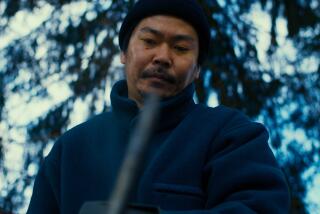Wim Wenders Finds a New ‘Tokyo’
- Share via
In 1983, filmmaker Wim Wenders traveled to Tokyo in order to rediscover the city that he had come to know and love through the films of the great Japanese director Yasujiro Ozu (1903-1963). “Tokyo-Ga” is Wenders’ fascinating and very personal documentary account of this journey.
What Wenders encountered during his visit was a high-tech and densely populated city that was far different from the folksier Tokyo depicted in such Ozu classics as 1953’s “Tokyo Story.” And the esteemed German director is quick to point out the discrepancy between the universal human qualities found in Ozu’s films and “the impersonal and even threatening” nature of contemporary Tokyo. As seen through Wenders’ roving camera, to live in this bustling metropolis is to be assaulted by a level of commercialism and tension that might even intimidate a lifelong New Yorker.
That the Japanese are workaholics is no great revelation. So Wenders instead gives us a glimpse of Tokyo denizens at leisure. In one memorable sequence, two rows of Japanese men--many of them in business suits--sit intently playing Japanese pinball in a “pachinko” parlor. Like the golfers we later see at a massive urban driving range, the poker-faced pinball players seem more concerned with practicing form and discipline than with winning.
Artfully shot and made on the run guerrilla-style, “Tokyo-Ga” also includes some lighthearted moments. In one endearing scene, a group of teen-agers joyfully dance in a park to prerecorded ‘50s rock ‘n’ roll. With their hair slicked back and sporting leather jackets, the boys look like they’ve been shaped by, perhaps, too many Elvis Presley and James Dean movies. Similarly, many of the girls sport ‘50s-style cardigan sweaters and long skirts. The Japanese may no longer value U.S. automobiles and consumer electronics, but they’ve long shown a remarkable affection for American pop culture.
Wenders does experience a bit of Ozu’s Tokyo when he encounters Chishu Ryu and Yuharu Atsuta. Ryu was an actor who appeared in many of Ozu’s films; Atsuta was one of the director’s cameramen. Through sometimes funny and touching interviews with both men, Ozu is revealed as having been a quiet, authoritative and deeply respected man.
There’s a palpable sadness at the heart of “Tokyo-Ga.” Not only does Wenders fail to find Ozu’s Tokyo, but it seems that Ozu himself has been forgotten by the Japanese public. When the aging Ryu is approached on the street by a group of middle-age women, they recognize him not as a star of many of the legendary director’s films, but as an actor in a recent TV series.
“Tokyo-Ga” (1985), directed by Wim Wenders. 92 minutes. Not rated.
More to Read
Only good movies
Get the Indie Focus newsletter, Mark Olsen's weekly guide to the world of cinema.
You may occasionally receive promotional content from the Los Angeles Times.







